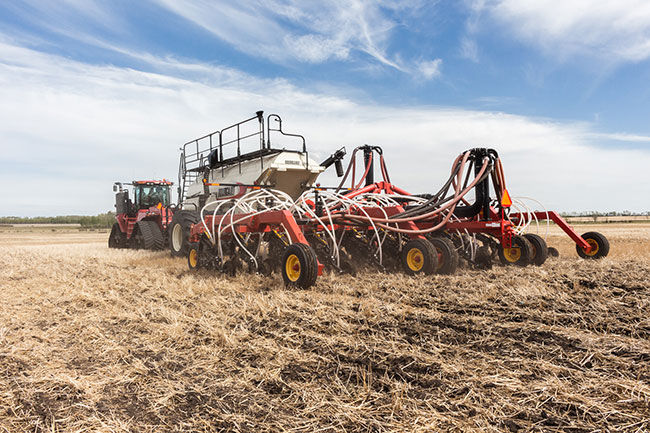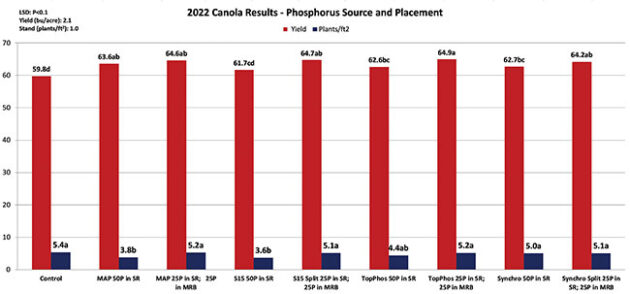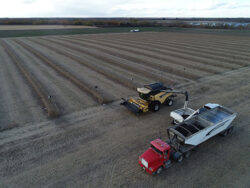
Features
Canola
Fertilizer
Flexible phosphorus placement in canola
Split midrow placement shows potential.
November 22, 2023 By Bruce Barker
 Agronomy trials found that a split application of phosphorus in a midrow band was a viable option.
Photos by curtis de gooijer.
Agronomy trials found that a split application of phosphorus in a midrow band was a viable option.
Photos by curtis de gooijer. The typical fertilizer phosphorus (P) recommendation is to place at least some P in the seedrow as part of a starter fertilizer application. However, canola is sensitive to seed-placed P, with the long-standing recommendation being no more than 25 pounds P2O5 per acre, as seedling toxicity may occur. This rate is typically less than what a canola crop requires for optimum yield and to maintain soil P fertility levels. Research from Bourgault Agronomy is exploring other placement options for canola growers.
“What we know about phosphorus is that it doesn’t move around in the soil, so what we wanted to experiment with, because phosphorus is typically applied in the seed row, was what happens if it is also applied in a midrow band,” says Curtis de Gooijer, agronomy team lead with Bourgault Industries at St. Brieux, Sask.
Bourgault operates a 2,500-acre farm at St. Brieux and conducts small-scale field trials that are 30 feet wide and 400 feet long, replicated three times. Over three years, from 2015 through 2017, trials examined placing 55 lbs P2O5 per acre in a midrow band, 55 lbs in the seedrow or a split application of 15 lbs in the seedrow combined with 40 lbs in the midrow band.
“We observed a slight yield response when placing phosphorus in the mid-row band. The split application provided a pop-up effect, and then the phosphorus in the midrow band was available for uptake later in the season,” says de Gooijer. “We also noticed that placing 55 lbs with the seed harmed the plant stand.”
This research prompted a new trial initiated in 2022, with two components. The first was to investigate various phosphorus products that might offer increased crop safety, enabling all the P fertilizer to be placed with the seed. The second was to further explore the potential of placing P fertilizer in a midrow band.
The four P products studied were the standard monoammonium phosphate (MAP; 11-52-0) at a 2022 cost of $0.88 per lb P2O5. The second was S15 (13-33-0-15) at a cost of $1.10 per lb. (The value calculated considered the value of the other nutrients and reflects only the cost of P in the blend). The third was TopPhos (8-30-0-6.4) at $2.51 per lb, and the product claims to have a lower salt index with better crop safety and increased availability. The fourth was Synchro (8-43-0-0 3.5Mg). Synchro is a 50:50 blend of MAP and CrystalGreen struvite. Struvite is recovered from wastewater and has been shown to be safer on the crop when placed in the seedrow at a cost of $1.47 per lb of P2O5.
There were three placement treatments, including the control with zero P fertilizer. The second treatment was 50 lbs P2O5 in the seedrow, comparing each of the four products. The third treatment was a split application of 25 lbs P2O5 in the seedrow and 25 lbs in the midrow band, again comparing all four products.

Midrow band shows potential
With one year of results from 2022, the preliminary findings show that the mid-row band has potential. When assessing stand establishment, which reflects crop safety, MAP, S15 and TopPhos all had statistically lower plant stands compared to the no P control when all the P was applied in the seedrow. However, Synchro had statistically similar stand establishment as the no P control when all the P was applied in the seedrow.
“With Synchro, the product claim of increased product safety did show up,” says de Gooijer.
When the P application was split between seedrow and midrow, all the products had statistically similar stand establishment as the control.
The lowest yield was around 60 bushels per acre from the zero P control. Applying all the fertilizer P in the seedrow did provide a small increase in yield for all products, although S15 was statistically similar to the no P control.
“What I find interesting was that if you look across the products with 50 lbs all applied in the seedrow, the yields are very similar,” says de Gooijer. “That shows canola was able to compensate somewhat for the lower stand establishment, but that usually means later maturity.”
Splitting the P application produced the highest yields between 64.2 to 64.9 bushels per acre.

Splitting phosphorus between the seedrow and sideband produced the highest yields.
“What I didn’t expect to see was that in every single product with the split application, even though the plant stand was similar to the control, there was a jump in yield with the split application,” says de Gooijer. “When we went into the trial, we wanted to see if a grower could put down P in the midrow and not hurt yield, but instead we saw a bump in yield.”
There could be several possible explanations, according to de Gooijer. One could be that the split application provides two feeding sites for roots throughout the growing season, with the midrow band placement about one inch deeper than seed-placed P. The other could be that P tends to become stratified closer to the soil surface in long-term no-till fields, and if the soil dries out near the surface, the plant may not be able to access that P later in the season.
For 2023, de Gooijer added two treatments to further investigate the reasons for the midrow P response. The first was to apply only 25 lbs P2O5 in the seedrow with no additional midrow P. He wants to see if there is a decrease in yield caused by high rates of P in the seedrow. The second treatment is to apply all 50 lbs P in the midrow to see if uptake from the midrow is adequate without starter P in the seedrow. These results will be available later in the winter.